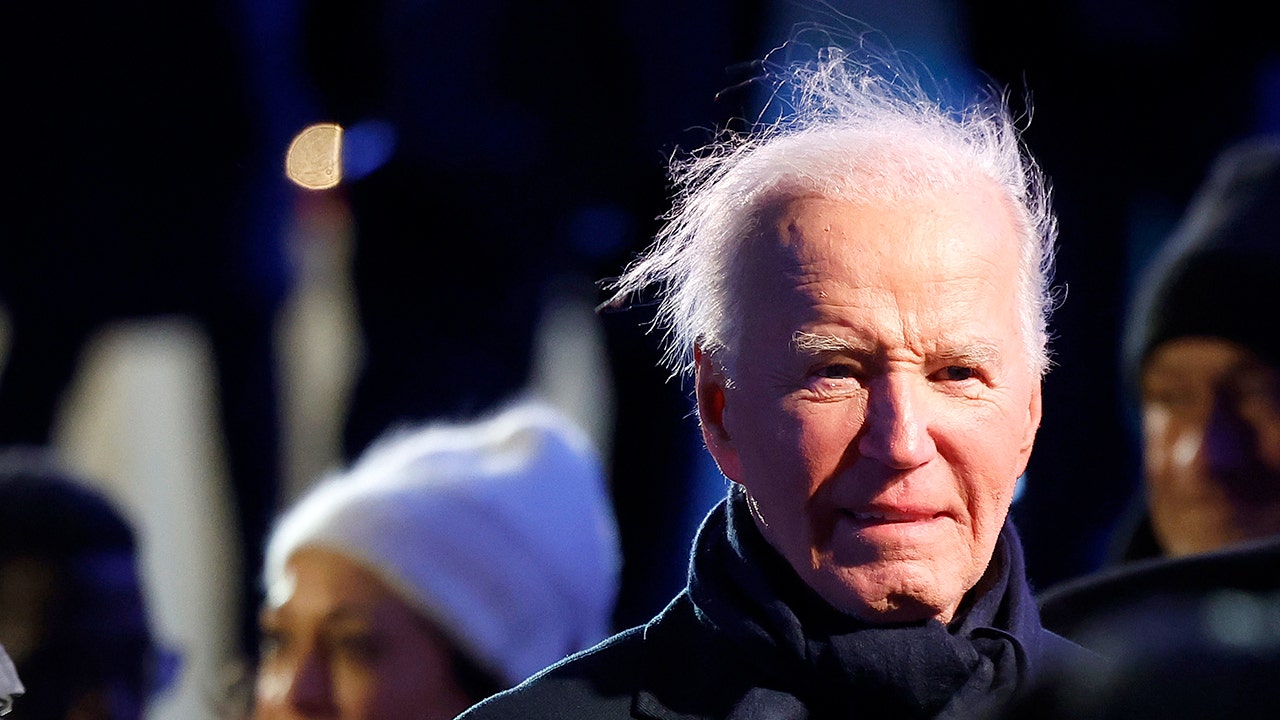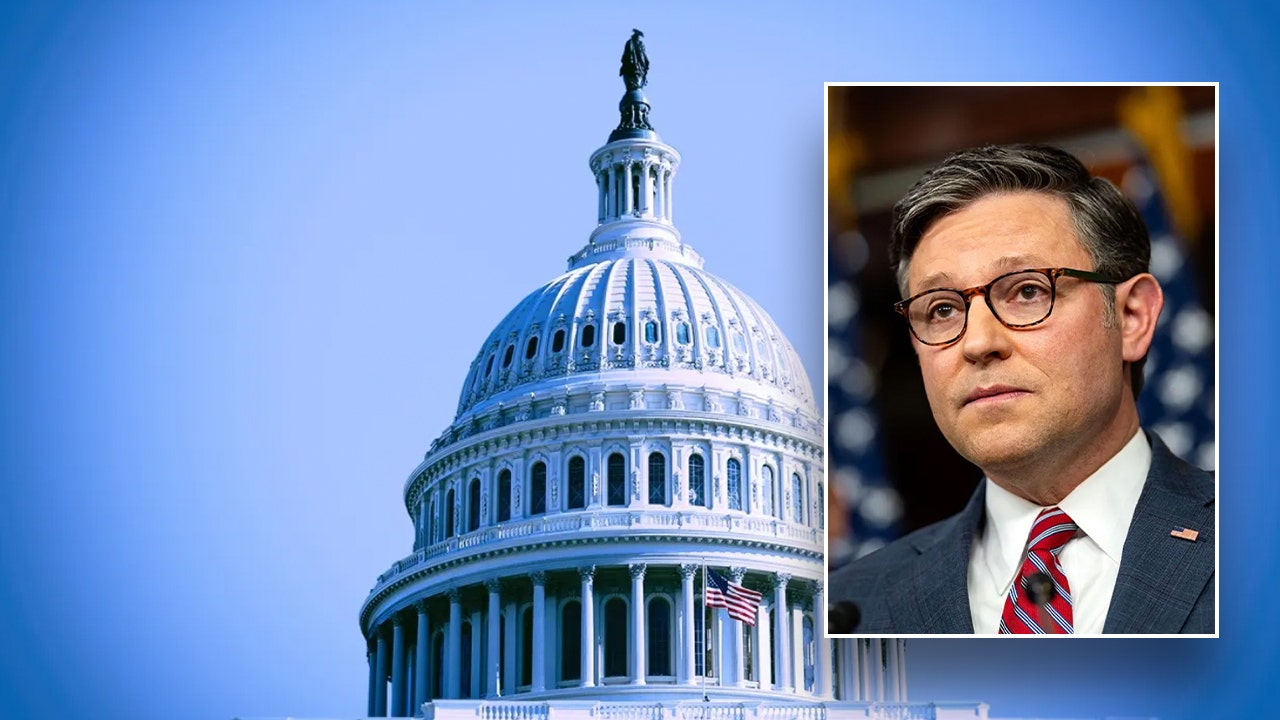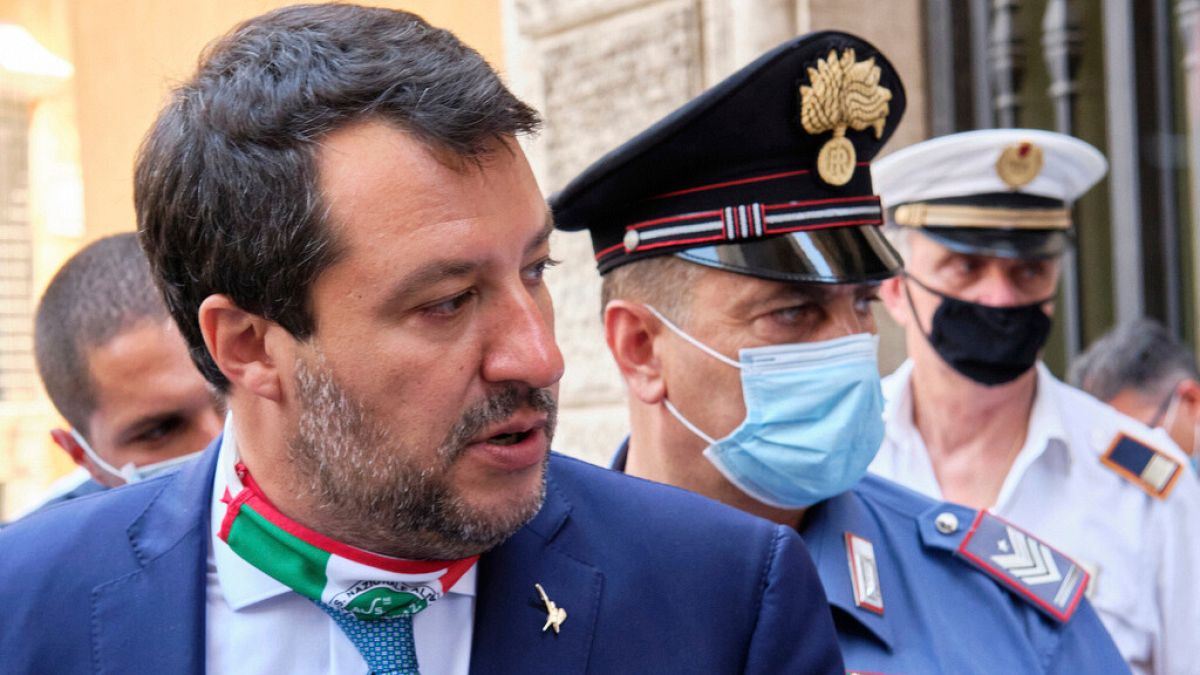North Dakota
Sandi Sanford, new leader of the NDGOP, fights off ‘extreme’ label from outside and within party

BISMARCK — The way Sandra Sanford is perceived, by people both inside and outside of the North Dakota Republican Party, is not how she sees herself.
Sanford, 51, who goes by Sandi, has been cast as part of an ultra-right faction that recently “took over” the party when she was elected as state GOP chairwoman.
Wife of the former Lt. Gov. Brent Sanford, she defeated incumbent party Chairman Perrie Schafer on June 16 in Fargo by a single vote.
She’s been labeled a “culture warrior” which she once called a “badge of honor,” but she also told The Forum she’s simply doing what most moms would do.
“As a culture warrior, am I a mom that has asked questions about what’s happening? Yes, I have and I am not going to apologize for the questions that I’ve asked,” she said.
The labels come from her stands against the COVID-19 vaccine and mask mandates, books with certain sexual content in school libraries and her belief that gay marriage threatens the sanctity of “biblical marriage.”
“I questioned the agenda … and that is what has now created this narrative of being extreme,” she said.
Nick Hacker, former NDGOP treasurer, was among the slate of five party leaders ousted in the June internal party election.
Screen capture of SBHE meeting
He said the move represents a further-right alignment, particularly on cultural issues.
“I can’t determine whether or not the underlying citizens of North Dakota have moved for the right or not, but the leadership definitely has,” Hacker said.
Sanford said some Republican colleagues think she’s too conservative and some think she’s too liberal, while she considers herself as being right down the middle.
She was warned that serving as state GOP chair would be “harsh and difficult,” but she wasn’t fazed, she said, because she has the necessary organizational and leadership skills.
“I work circles around most people,” she said, and has the desire to set up the party for success beyond her term.
Sandi Sanford and her husband live in Bismarck and have two daughters and a son; Sydney, 23, Nicolas, 15, and Erin, 12.
She grew up on a family farm near Minot, which she now owns, and was involved in health care for 30 years, working as a respiratory therapist. She’s been involved in state politics for more than 25 years.

Will Kincaid / The Bismarck Tribune
Sanford said she was approached twice to run as state GOP chair and declined both times.
As the election drew near, she sat down with “the right people” who convinced her to run.
“They believed that I could assist in bridging the gap to a kind of fractured party that has been in place for many years,” she said.
In addition to Sanford’s election as chairwoman, John Trandem was elected first vice chairman, Jennifer Benson as second vice chairwoman, Andrew Bornemann as secretary and Stephen Hillerud as treasurer.
Sanford said she’s heard fearful and angry dialogue from certain people about those results, some of it “inappropriate.”
“They feel that the North Dakota Republican Party was taken over and … the foundation of what makes it great has been lost to five people,” she said.
Sanford said there was no takeover, as she didn’t even know several of the people in those new leadership positions until election day.
She was a good friend beforehand to Benson, who is executive director of American Experiment North Dakota and a former Fargo School Board member.
Benson said Sanford is approachable, kind and experienced, and can work with other Republicans who’ve swayed from party principles, voting too closely with Democrats.
“She’s standing for the party principles as they are stated … individual liberty, personal responsibility, limited government. That doesn’t make her an extremist,” Benson said.

Submitted photo
John Odermann, former first vice-chair of the NDGOP, said while Sanford might not be a “far-right radical” or think of herself in those terms, that is the faction of the party that elected her as chair.
He said he’d like to ask Sanford this question: “The people that you would say you’re closely aligned with politically are not the ones who voted for you. So how do you square that?”
‘The left agenda … getting so bold’
Sanford describes herself as a Ronald Reagan kind of Republican, a reference to the U.S. President from 1980-1988 often cited for championing smaller government, tax cuts and a strong military.
But her views on certain cultural and social issues are where she draws the greatest criticisms from Democrats and even a fair number within her own party.
She said she’s always been considered “too far right” because of her religious beliefs and anti-abortion views.
But that perception intensified during the COVID-19 pandemic, when she spoke out against vaccines and mask mandates, even quitting her job when told she was told she had to be vaccinated.
With several other women, Sanford created the North Dakota Conservative Advocate, now called North Dakota Can, to push back against mask requirements for school children.
She also was particularly concerned about “extreme overreach” relating to shutdowns, especially in senior long-term care.
Regarding LGBTQ issues, Sanford said she has friends and family in that community.
“I think that’s a difficult place to be for them, and it’s a difficult walk,” she said.
Though she believes only in “biblical marriage” between a man and a woman, she knows people who live outside of that and still loves them, she said.
North Dakota lawmakers took on numerous LGBTQ bills this past legislative session,
passing one that prohibits transgender K-12 students from using bathrooms that align with their gender identity, and that bars schools from adopting policies relating to a student’s preferred gender pronouns.
Sanford cited a new law in Michigan that expands that state’s hate crime legislation.
She claimed under the law, a person can be charged with a felony crime in Michigan if they call someone by the wrong pronouns, an interpretation repeated by a number of conservative critics.
Others point out the word “pronoun” does not even appear in the Michigan bill, which focuses more on threatening conduct than speech.
Sanford doesn’t necessarily consider that a “hate crime” bill, she said. She has her own convictions and values and won’t compromise them because someone else believes differently, she said.
Culturally, there’s a lot happening quickly, and people are unsure how to adjust, she said, citing incidents during the recent Pride Month, during which a group rode bicycles naked in a parade in Seattle where children were present.
“The left agenda and what that is is getting so bold,” she said.
She also got in the middle of an issue involving what she said is a sexually explicit, inappropriate book in a Bismarck high school.
Titled “This Book is Gay,” by Juno Dawson, the book offers help in coming out, how to meet others who may be LGBTQ and the ins and outs of gay sex.
She met with the president of the school board and the book was removed, she said.
Sanford believes in school choice; of her two youngest children, her son attends public school while her 12-year-old daughter goes to a private Christian school.
For her “littler one,” Sanford said private school seemed a better place, because “she didn’t have as many opinions as my son did.”
Some may wonder whether Sandi Sanford and husband Brent Sanford are lockstep in their political beliefs, the answer to which she said is “no.”
“We’re people and we’re human. I have my own brain and he has his own brain,” she said, adding that she feels more strongly about certain issues than he does.
“We make a good team because he’s really quiet and I’m really not,” she said with a laugh.
He tells her she’s been through “the meat grinder” of politics even more than he has during his time as lieutenant governor and, previously, as mayor of his native Watford City, North Dakota.
Sandi Sanford said she has no aspirations for any other political office — her only goal being elected NDGOP chair and helping other Republicans get elected.
Odermann said he sees two paths forward for the state party: airing grievances in knee-jerk fashion on social media, or continuing the 30 years of dominance of the party by relationship building.
He said the latter is something the former NDGOP executive committee excelled at. When there were disagreements, they sat down and hashed things out behind closed doors.
He’s somewhat concerned that certain party donors asked for refunds after Sanford and the rest of the new executive committee were elected.
“We have to get back to being the happy warriors,” Odermann said. “I think we’ve leaned a little too much into the Donald Trump approach to things and that’s not good for our politics.”
Any feedback or pointed criticism from fellow Republicans, columnists and bloggers doesn’t offend Sandi Sanford because she said she has “tough skin.”
“It’s only kind of helped me. I’m a lady. I’m gonna just stay in my lane,” she said. “I’m not gonna apologize for being conservative.”

North Dakota
Port: As the federal government teeters on edge of shutdown, North Dakota has no vote

MINOT — Barring some late-breaking legislation, the U.S. federal government will shut down within hours.
As this drama unfolds in Washington, North Dakota has no voice in the U.S. House of Representatives. The legislative body where, per Article I, Section 7 of the U.S. Constitution, all bills raising revenue must originate.
As I write this, Speaker Mike Johnson, a Republican,
is confident
they’ll avoid a shutdown despite funding agreements getting scuttled twice in recent days. Once thanks to agitation from billionaire Elon Musk and once again thanks to a group of House Republicans who refused to agree to raise the national debt ceiling without significant spending cuts.
Given the turmoil in the House Republican caucus and the narrow margins of the Republican majority, any potential deal may pass by only a scant few votes. Which is another way of saying that, in this fraught moment, no side in the debate has any votes to spare.
But a vote from North Dakota won’t be among them. That’s because former U.S. Rep. Kelly Armstrong resigned his seat in the House on Dec. 14 so he could be sworn in as governor on Dec. 15, which
Article V, Section 5
of the North Dakota Constitution requires. Meanwhile, Rep.-elect Julie Fedorchak is waiting in the wings, but she was elected to the next Congress, not this Congress, so she cannot be seated.
I actually spoke to Armstrong about this drama
in April.
Given the resignations of other House Republicans, it seemed at that time the GOP could lose control of the House before the current Congress ended. Armstrong was confident that the party would replace members through special elections between now and then and he was right. The GOP held onto its majority, slim as it is.
As for Armstrong’s vacancy? “After June 11, we will be keeping the speaker’s office informed,” he also told me at the time, referring to the primary election.
“It’s confusing for folks because they don’t know who is our representative right now,” Fedorchak told me when I spoke to her about it.
She’s feeling flummoxed because there is nothing she can do. Fedorchak was not elected in a special election to replace Armstrong in this Congress. She was elected to fill North Dakota’s at-large seat in the next Congress.
By law, she cannot be seated in this Congress. The next Congress won’t be seated until January. Also, unlike senators, members of the U.S. House can’t be appointed. Outside of holding a special election, there’s no mechanism to fill Armstrong’s vacancy.
This circumstance isn’t anything Armstrong or Fedorchak can remedy. What’s caused it is constitutional law and dysfunction in Washington. North Dakota’s constitution necessitated Armstrong’s resignation from the House so he could be sworn in as governor. The U.S. Constitution prohibits North Dakota from appointing an interim replacement.
Alyssa Goelzer/The Forum
“This isn’t even really a budget fight,” Armstrong spokesman Mike Nowatzki told me. “It’s a CR fight. Congress should do its job and not govern by crisis.”
“He informed them when he was running for governor that this was a possibility. It shouldn’t surprise them that he had a hard out on Dec. 14,” Nowatzki added.
Which may be something for the Legislature to consider going forward. Can the new governor be sworn in at a later date? The timing is already awkward. The state constitution also mandates that lawmakers begin their regular session in January after an election. It also requires an organizational session in mid-December, complete with a budget address from the governor. This year, that was Doug Burgum, who was obliged to deliver an executive budget to lawmakers
as a lame duck just days from leaving office.
Armstrong’s feeling “is that having the governor be sworn in on the day before a legislative session wouldn’t be a good idea,” Nowatzki told me, referring to a possible delay in the swearing-in.
“It’s already a mad scramble,” Nowatzki added. “It would be exponentially more difficult.”
The situation with North Dakota’s at-large House seat is unusual. But the outgoing governor delivering a budget as a lame duck? That happens every time we get a new governor.
This timeline could be reshaped to serve the public better, but that’s easier said than done. Moving the swearing in date to a later time might mean moving the legislative session to a later start. I don’t sense there would be much appetite among lawmakers to do it, and even if there were, it would be a change to the state constitution that would have to be ratified by a vote of the people.
Meanwhile, in Washington, as Republicans fight with Democrats (and other Republicans) over the budget, North Dakotans have no official say in the matter.
North Dakota
North Dakota Outdoors: Look back at ND spearfishing

Submitted Photo
Decoying a pike isn’t the same as decoying ducks or holding a draw on a deer. Photo by Ashley Peterson, NDGF.
Have you ever been darkhouse spearfishing for pike? It’s relatively new compared to most outdoor recreation, having started a mere 25 years ago, but for those who have taken the opportunity it’s hard to compare.
I remember the first time I went spearfishing at Spiritwood Lake. Sitting still in a darkhouse was like nothing I’d ever done before. I’m no expert but when the first northern drifted into the decoy as I sat undetected, I locked up. Not surprisingly, I missed it.
Maybe it’s close to the thrill of calling turkeys into a decoy? Others might describe the rush like sitting undetected in a tree stand archery hunting for deer. I can attest it’s a rush of its own unique draw.
Decoying a pike isn’t the same as decoying ducks or holding a draw on a deer. None of those take place in the middle of a frozen lake with nothing but ice and cold water between you and the pike.
If you’ve ever watched a pike come in and attack a decoy, it’s incomparable. To get to that point is not easy. The combination of cold, snow and dark could be why the popularity of darkhouse spearfishing hasn’t, and likely never will, rival the sun, waves and water of summer fishing?
Looking at last year’s spearfishing statistics prove how a warmer winter with poor ice conditions results in lower participation and success.
Greg Power fisheries division chief highlights a few notes:
– 3,109 individuals registered – 2,018 residents, 1,091 nonresidents from 29 states including 716 from Minnesota (23%); despite an open winter, the number of registrants were similar to the previous winter, which was greatly impacted by extreme cold weather and snowfall.
– 9,181 northern pike were harvested, the lowest number since 2010-11 and less than one-third of that harvested in 2017-18 (the record year).
– Average spearer was 42.8 years old and 88% were male.
– Survey respondents indicated participation in DHSF on a record 138 water bodies (up 32 from 2021-22).
– DHSF effort of the top 15 lakes accounted for nearly 75% of the effort with Sakakawea accounting for about 35% of the total effort (which basically equaled the effort of the next 10 water bodies).
– Top 14 lakes accounted for more than 73% of the DHSF pike harvest with Sakakawea accounting for 28% of the total harvest. The top four waters (Sakakawea, Devils Lake, Twin (LaMoure) and Horsehead lakes) accounted for 56% of the total pike harvest.
– Median and mean weights of the largest pike reported harvested by respondents were 10 and 10.5 pounds respectively. These metrics are the highest ever recorded.
– 2022-23 was the first winter that the taking of walleye (in addition to pike and rough fish) during DHSF was legal for Devils Lake, Stump Lake and the Missouri River System including lakes Sakakawea and Oahe. For this past winter (23-24), the following number of spearers harvested the following number of walleye: Sakakawea (88 spearers and 218 walleye), Devils Lake (26 spearers and 54 walleye), Missouri River (three spearers and three walleye) and Stump Lake(one spearer and one walleye).
2024-25 ND darkhouse spearing
Individuals required to possess a valid fishing license (age 16 and older) to darkhouse spearfish must first register online at the North Dakota Game and Fish Department website, gf.nd.gov.
Darkhouse spearing is allowed for all anglers with a valid fishing license and for youth under age 16.
Northern pike and nongame fish are the only legal species statewide, while walleye can be speared at Stump Lake and the Devils Lake complex south of U.S. Highway 2 and the Missouri River System (including lakes Oahe and Sakakawea and the Missouri River) up to the first tributary bridge.
Spearers and anglers are reminded that materials used to mark holes must be in possession as soon as a hole greater than 10 inches in diameter is made in the ice.
Registration and full details can be found on the Game and Fish Department’s website.
North Dakota
Nelson County farmer credited with saving men from freezing to death after crash

MCVILLE, N.D. — Nobody knows the land around North Dakota better than farmers, and that knowledge proved critical after a bizarre car crash in Nelson County.
Sheriff Kurt Schwind said an unnamed farmer’s help was lifesaving after rescue crews called off an initial search for the occupants of the vehicle and nearly halted a second one.
If the second search had been called off, Schwind said, two men likely would have frozen to death.
County dispatch received the call about the crash around 6 a.m. on Dec. 9; the caller became disconnected.
“Says he was sleeping, he was in the car with a couple guys, he was sleeping, woke up they were gone, the vehicle was crashed so he started walking,” Schwind said.
The call came from a refurbished phone, so officers were not able to call the person back, but a cellphone ping brought them to the farmstead.
Bodycam footage obtained by WDAY shows a Nelson County sheriff’s deputy talking with the farmer, who was curious about all of the police activity on his property.
After searching for about an hour and a half, police called off the search until sunrise.
“It was so dark and we had some blowing snow and stuff like that, so it was really hard to see anything at that point,” Schwind said.
When the sheriff returned after sunrise, the farmer showed him something.
“That’s when the landowner realized that this gate had been broken through,” Schwind said.
The tracks the farmer and police followed for a half-mile through a cow pasture were still visible days later. A wire fence was also driven through. It led investigators to the top of a ravine, and several hundred feet below, they spotted a four-door car.
“How they got through there with that BMW is amazing, because we had to use four-wheel drive, and we struggled getting down there,” Schwind said.
At about the same time, Schwind found the man who called 911. He had climbed the ravine and sought shelter in some hay. He had no shoes or coat. He told police he was alone.
“He was in bad shape. As soon as I got him into my vehicle, he had uncontrollable shivering; he was very incoherent,” Schwind said.
As the sheriff raced the man to the hospital, the farmer, who had stayed at the top of the ravine, made another key discovery.
“He got his binoculars out and saw him sitting in the trees,” Schwind said of another man.
It took rescue crews nearly an hour to rescue the second man. According to WDAY StormTRACKER meteorologists, the wind chill was below zero.
“I think if the landowner wouldn’t have met me back over here, that we would have been recovering as opposed to finding,” Schwind said.
The sheriff said the men were traveling from Grand Forks to Devils Lake, but it’s unclear how long they were in the ravine and how they ended up several miles off the main road.
“They both had phones that had charges left in them,” Schwind said. “For some reason, they didn’t call — they only called that one time and didn’t call again.”
While WDAY News was talking with the sheriff for this story, a deputy found a jacket, boots and phone a couple hundred feet from where the first man was found in the hay. What looked like methamphetamine was found in a pill container in the jacket pocket.
The Nelson County Sheriff’s Office plans on presenting the farmer with an award for his lifesaving help.
The Sheriff’s Office is still investigating to determine if the men will face charges.
McVille is about 67 miles southwest of Grand Forks.
Matt Henson is an Emmy award-winning reporter/photographer/editor for WDAY. Prior to joining WDAY in 2019, Matt was the main anchor at WDAZ in Grand Forks for four years.
-

 Politics1 week ago
Politics1 week agoCanadian premier threatens to cut off energy imports to US if Trump imposes tariff on country
-
/cdn.vox-cdn.com/uploads/chorus_asset/file/25782636/247422_ChatGPT_anniversary_CVirginia.jpg)
/cdn.vox-cdn.com/uploads/chorus_asset/file/25782636/247422_ChatGPT_anniversary_CVirginia.jpg) Technology1 week ago
Technology1 week agoInside the launch — and future — of ChatGPT
-
/cdn.vox-cdn.com/uploads/chorus_asset/file/25789444/1258459915.jpg)
/cdn.vox-cdn.com/uploads/chorus_asset/file/25789444/1258459915.jpg) Technology7 days ago
Technology7 days agoOpenAI cofounder Ilya Sutskever says the way AI is built is about to change
-

 Politics7 days ago
Politics7 days agoU.S. Supreme Court will decide if oil industry may sue to block California's zero-emissions goal
-
/cdn.vox-cdn.com/uploads/chorus_asset/file/25546252/STK169_Mark_Zuckerburg_CVIRGINIA_D.jpg)
/cdn.vox-cdn.com/uploads/chorus_asset/file/25546252/STK169_Mark_Zuckerburg_CVIRGINIA_D.jpg) Technology1 week ago
Technology1 week agoMeta asks the US government to block OpenAI’s switch to a for-profit
-

 Politics1 week ago
Politics1 week agoConservative group debuts major ad buy in key senators' states as 'soft appeal' for Hegseth, Gabbard, Patel
-

 Business5 days ago
Business5 days agoFreddie Freeman's World Series walk-off grand slam baseball sells at auction for $1.56 million
-
/cdn.vox-cdn.com/uploads/chorus_asset/file/23951353/STK043_VRG_Illo_N_Barclay_3_Meta.jpg)
/cdn.vox-cdn.com/uploads/chorus_asset/file/23951353/STK043_VRG_Illo_N_Barclay_3_Meta.jpg) Technology5 days ago
Technology5 days agoMeta’s Instagram boss: who posted something matters more in the AI age




















